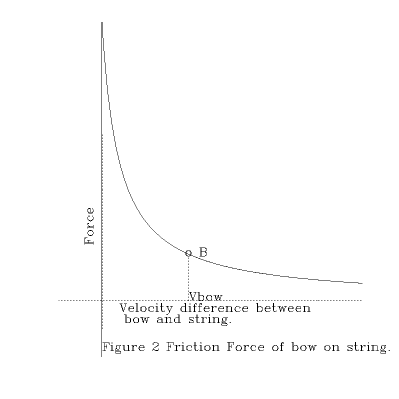
The violin is probably closest in its operation to the clarinet, in that it does not use time delay to get the negative resistance. In this case, what is used is a peculiar property of a substance called rosin. The whole purpose of a violin bow is to hold a goodly supply of rosin. The horse hairs used to do this have small scales on them which pick up small particles of rosin from the cake of rosin over which the bow is dragged before playing a piece.
Rosin has the peculiar property that if there is no motion between the rosin and the string, the string tends to stick to the rosin. Once the string begins to move however, the force of friction between the rosin and the string drops rapidly, and the faster the string moves past the rosin, the less friction force there is. Figure 2 is a sketch of the force of friction, the force which the rosined bow exerts on the string in the direction of motion of the bow.

Let us imagine that the bow is pulled across the string with some velocity, and let us assume that the string is at rest. The bow will exert a small force on the string which will distort the string slightly. Now assume that the string vibrates a bit, so that the string moves a little bit in the direction of the bow's motion. The velocity of the string with respect to the bow gets slightly less, and as a result we move to the left in the force versus velocity curve. The friction force of the bow on the string increases. Similarly, if the string moves a bit in the direction opposite to the bow's motion, the velocity between the string and bow increases, and the friction force drops. This is just like one pumps up the child on the swing. When the string moves in the direction of the bow, the force in that direction increases, while if it moves in the opposite direction, the force decreases. This will "pump up" the oscillation of the string, creating the negative resistance.
In fact for most violin strings and bowing, the oscillation pumps up until during part of its oscillation the string sticks to the bow, and at another part, the string is released and moves with almost constant velocity in the opposite direction to the bow. The velocity of the string looks like a square wave, with the "duty cycle" (the fraction of time the string is not stuck to the bow) being just equal to the fractional distance from the bridge that one is bowing. Since the average velocity of the string over a complete cycle of oscillation is zero (on average it does not move with respect to the violin), the velocity while it is not stuck to the bow is higher than the velocity of the string when it is stuck (that velocity is just the velocity of the bow). Note that to play a louder sound on the violin, one must pull the bow faster. Pressing harder just makes the friction force higher, it does not change the oscillation of the string ( unless the pressing force is so high that the string cannot release from the bow, or is so low that the string never sticks to the bow). It is purely how fast you pull the bow across the string which determines how loud the sound is.
Again for the violin it is the rather counter-intuitive behaviour or rosin which leads to the negative resistance.
Note that there are other times when a procedure very similar to violin bowing occur. One is chalk on the blackboard. If you hold the chalk in the right way, (with the chalk sloped so that the edge doing the drawing in front of the rest of the chalk one can again get this same kind of negative resistance. In this case as the chalk in its natural mode of vibration moves toward the blackboard, the tip jams up against the board and increases the friction force. When it moves away, it releases from the board, again giving the result that when the chalk is tip is moving backward, (away from the average motion of the chalk) the backward force of friction is high, increasing the backward motion of the chalk tip, and when the chalk tip is moving forward, the force of friction is very low, increasing the tendency to more forward. This creates that highly unpleasant sound of chalk squealing on the board.
A similar behaviour of rosin is alcohol on your finger tip rubbed around a wine glass to amplify the natural oscillation of the wine glass.